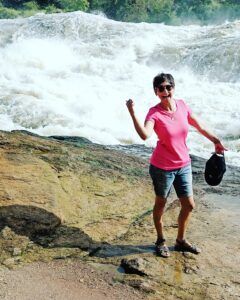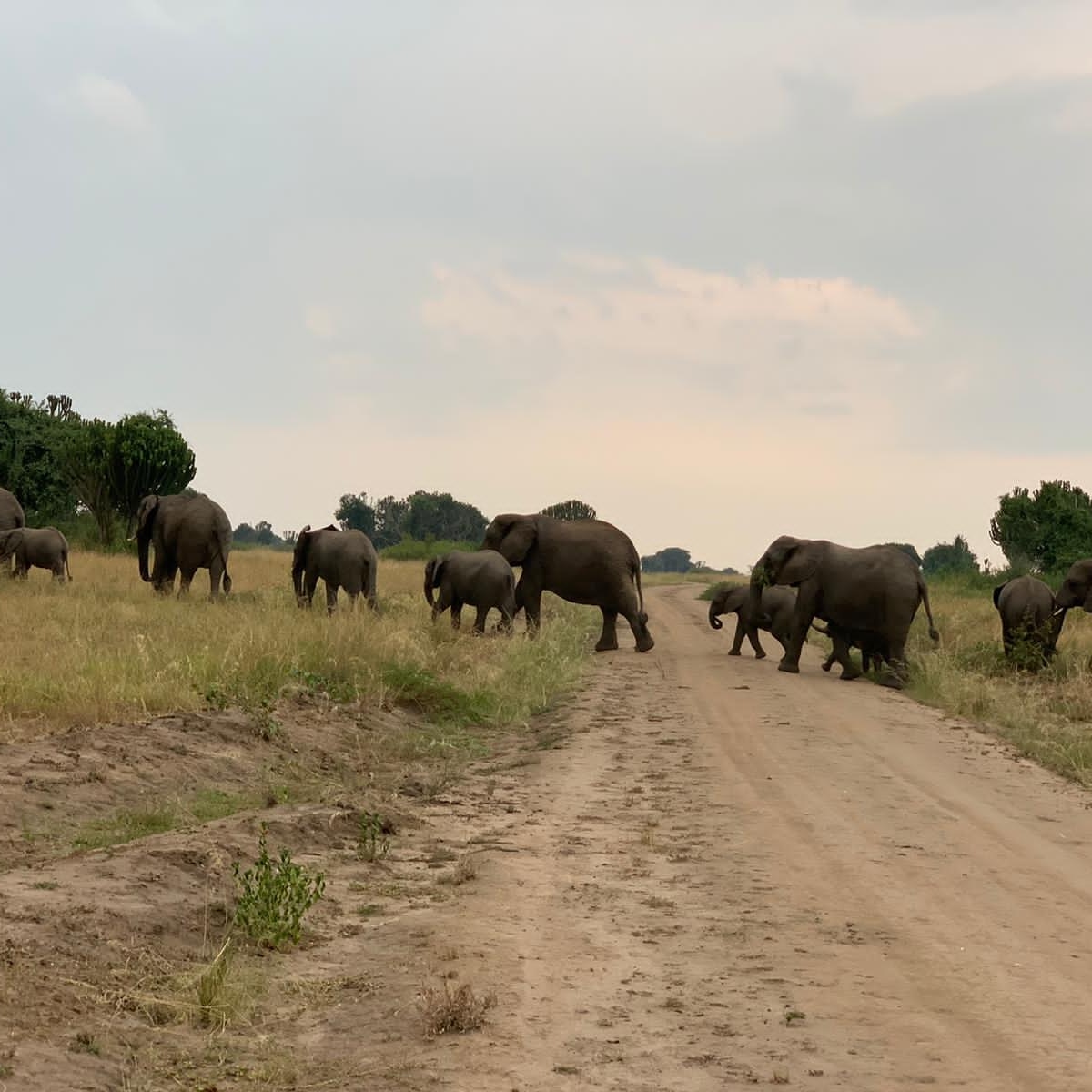MURCHISON FALLS NATIONAL PARK
 At the northernmost point of the Albertine Rift Valley, where the expansive Bunyoro escarpment mixes with a wide, palm-dotted grassland, is where Murchison Falls National park is located. It is one of Uganda’s oldest protected areas and was first listed as a game reserve in 1926 before being upgraded to a park in 1952. Moreover, it is the biggest. Its combined size with the adjacent Karuma and Bugungu wildlife reserve is 5072km2, and it is home to 451 different bird species and 76 different mammal species. The Victoria Nile cuts through the national park in two places, speeding through a sequence of rapids for 80 kilometers before bursting through a small (6-meter) opening in the ruins of the rift valley cliffs. The river’s force is depleted by this 45-meter drop, which changes the torrent into a broad, tranquil flow that silently across the rift valley floor towards Lake Albert.
At the northernmost point of the Albertine Rift Valley, where the expansive Bunyoro escarpment mixes with a wide, palm-dotted grassland, is where Murchison Falls National park is located. It is one of Uganda’s oldest protected areas and was first listed as a game reserve in 1926 before being upgraded to a park in 1952. Moreover, it is the biggest. Its combined size with the adjacent Karuma and Bugungu wildlife reserve is 5072km2, and it is home to 451 different bird species and 76 different mammal species. The Victoria Nile cuts through the national park in two places, speeding through a sequence of rapids for 80 kilometers before bursting through a small (6-meter) opening in the ruins of the rift valley cliffs. The river’s force is depleted by this 45-meter drop, which changes the torrent into a broad, tranquil flow that silently across the rift valley floor towards Lake Albert.
One of the best animal shows may be found in the river below the falls. Elephants, giraffes, and buffalo frequently visit the riverbank, while hippos, Nile crocodiles, and aquatic birds live there permanently.
BRIEF HISTORY OF MURCHISON FALLS NATIONAL PARK
The Murchison Fall Conservation area was initially explored by John Speke and James Grant in 1862. Later, Samuel and Florence Baker went there in 1863–1864. He then gave it the name Murchison Falls in honor of the then-president of the Royal Geographical Society, geologist Roderick Murchison.
Residents were relocated from the area between 1907 and 1912 as a result of sleeping sickness brought on by tsetse flies. The Bunyoro Game Reserve was established in 1910 in the modern-day Masindi, Buliisa, and Kiryandongo districts, south of the Nile.
The boundaries were then expanded in 1928 to include the modern-day Nwoya district to the north of the river. The Ugandan National Parks Act was established by the British government in 1952. The region eventually earned the name Murchison Falls National Park.
Murchison Falls was not just the most popular park in Uganda during the 1960s but also one of the most well-liked in all of Africa. The big 5 (lopads, lions, elephants, buffaloes, and rhinos) and chimpanzee populations were abundant in this area. Some of Africa’s highest wildlife densities could be found in this park, where an estimated 15,000 elephants, 14000 hippos, and 26,500 buffalo roamed the savannas with their distinctive stampedes.
Civil wars, however, sank these in the 1970s and the first part of the 1980s. After the battles, only 200 elephants were determined to have survived, and wildlife populations continued to dwindle. Additionally, there were fewer hippos and buffaloes—about 1,000 each—than there formerly were.[/vc_column_text][/vc_column][vc_column width=”1/4″][vc_column_text]
ACCESSIBILITY TO THE PARK
ROADS
There are several ways to get to Parea, the park’s primary tourist location, where a car ferry crosses the Nile nearly every hour all day long.
Southern Entrance Gate
There are two ways to go to Paraa from Masindi Town, which is 305 kilometers from Kampala. Drive time is four hours. The 86 km route is the shortest and enters the park by the Kichumbanyobo gate, 16 km from Masindi. The center of the Murchison game viewing region, the Kaniyo Pabidi section of the Budongo forest, and Murchison Falls are stops along the route. Masindi to Paraa via Bulisa is a longer, more beautiful alternate route (136km). The route travels through the Budongo Forest before making a dramatic descent of the rift valley escarpment with views across Lake Albert to the Blue Mountains of the Democratic Republic of the Congo. The Bugungu or Mubako gates allow access to the park.
Northern Gate Entrance
Murchisson Falls, the Chobe, Wankwar, and Tangi gates are additional access points to the national park on the north bank of the Nile. These are all accessible from the 260km2 Kampala-Packwach road, which spans the Nile at Karuma Falls in the northwest portion of the park.
AIR
From Entebbe International Airport or Kajjansi Airfield in the Kampala area, hired aircraft can fly to Pakuba Airfield, which is 19 kilometres from North Paraa. Chobe to the east and Bugungu to the south of Paraa are two more airfields in the park.[/vc_column_text][vc_column_text]
WHEN CAN ONE VISIT THE PARK?
All seasons are wonderful at Murchison Falls National Park, but December through February are regarded as the ideal months to visit. Another fantastic time to go is from June through September. Little rain falls during these months, so the tracks you follow on your game drives to find wildlife remain dry and open. Animals are drawn to water sources during the dry season, making it simpler to see them while on game drives.[/vc_column_text][/vc_column][vc_column width=”1/4″][vc_column_text]
ATTRACTIONS AND ACTIVITIES IN THE PARK
PARAA
This is where boat journeys to the falls and the delta begin, as well as where the car ferry crosses. As a result, the majority of the lodging for visitors to the park is nearby, much of it on the riverbank 5 kilometers to the west of the park.
THE NILE AND MURCHISON FALLS
Murchison Falls Boat Cruise.
The park’s oldest and most well-liked activity is a launch boat trip upriver from Paraa to watch the Murchison Falls bursting through the calls at the top of Fajao Gorge. On the three-hour return trip, a variety of riverfront species, including resident hippos and crocodiles and visiting elephants, buffalo, etc., can be seen along the way.
Top of the Falls
Visitors should be sure to walk to the top of the Falls viewpoint to see, hear, and feel the Nile rumble through a gorge that is 6 meters wide. Although a vehicle can get to the location, it is more satisfying to get off the launch and hike through Fajao Gorge to the top of the falls.
Delta Boat Cruises
Additionally, boats depart from Paraa and travel downstream to the Nile Delta, where a patchwork of papyrus islands obstructs the river’s entrance to Lake Albert. Most notably, the shoebill, they are abundant in water birds.
Sport Fishing
Given that the record Nile perch caught using a rod and line weighs a massive 108 kg, the river below Murchison Falls offers a thrilling challenge for fishermen.
GAME VIEWING
Buligi Peninsula
 The Buligi peninsula, a triangle of grassland defined by the Victoria Nile entering Lake Albert and the Albert Nile flowing out of it, is the best place in the park to watch wildlife. Expect to see antelopes, giraffes, elephants, and buffalo; cross your fingers for lions and leopards.
The Buligi peninsula, a triangle of grassland defined by the Victoria Nile entering Lake Albert and the Albert Nile flowing out of it, is the best place in the park to watch wildlife. Expect to see antelopes, giraffes, elephants, and buffalo; cross your fingers for lions and leopards.
Visitors can also fly in a hot air balloon to explore the plains to the north and west of Paraa. Make contact with Paraa Safari Lodge’s Jobihani Dream Ballons.
Heart of Murchison
The Murchison Falls National Park’s core is a lovely area of savannah, in contrast to the southern portion of the park, which is largely covered by bush and forest. Vehicle tracks have just been opened in the region, which is rising to prominence as a top lion habitat due to big herds of Uganda Kob.[/vc_column_text][/vc_column][vc_column width=”1/4″][vc_column_text]
FOREST WALKS AND CHIMPANZEE TRACKING
Kaniyo Pabidi Forest
A colony of habituated chimpanzees lives in this forest to the south of the Murchison Falls Conservation Area, and it is possible to track them with knowledgeable forest guides. Due to the presence of endemics to the Albertine Rift and other species with “limited range,” such as the chocolate-backed kingfisher, white-thighed hornbill, and Puvel’s illadopsis, Kaniyo Pabidi is also a crucial location for birdwatchers.
BIRDING
Birding excursions coincide with the places mentioned above for observing animals. Highlights include simple sightings of the local and aquatic birds on the boat to the Falls, thrilling shoebill sightings in the Nile delta, and meticulous hunts for rare and restricted range forest species in Kaniyo Pabidi Forest.
CULTURAL ENCOUNTERS
An electrifying performance by Mubako dancers around lodge campfires creates a magical African atmosphere at dusk. The Boomu Women’s Group provides lodging, a craft store, and village visits that highlight the reality of living in this remote area.[/vc_column_text][/vc_column][/vc_row]